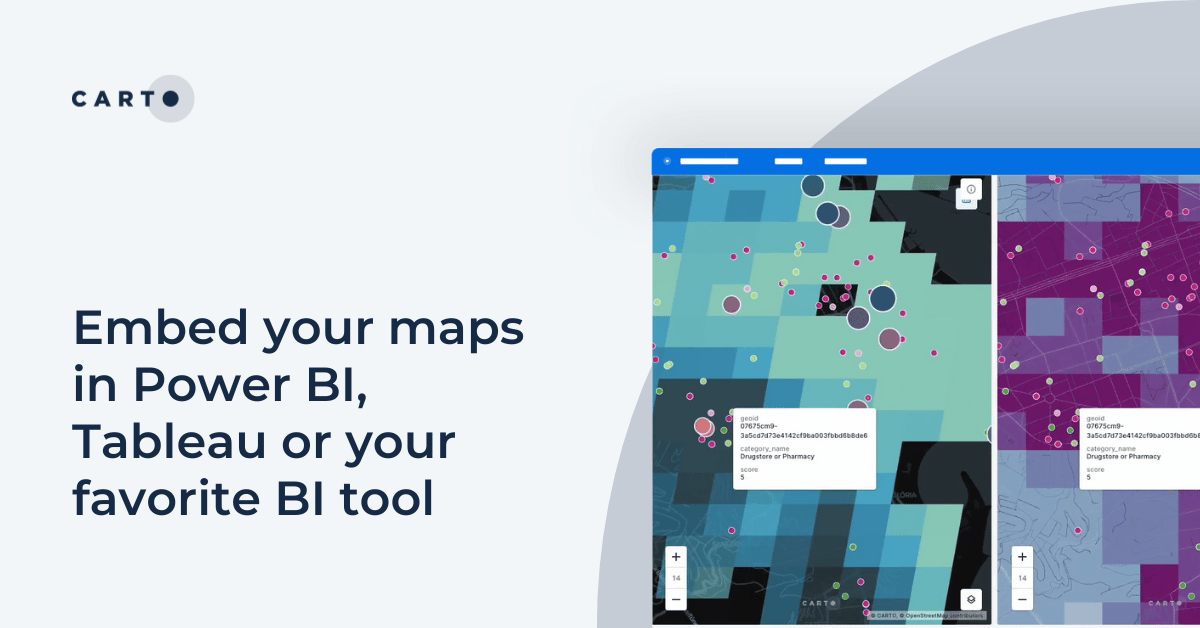Embed your maps in Power BI, Tableau or your favorite BI tool

In today's data-driven world, organizations across all industries are increasingly relying on data analytics to gain a competitive edge in an ever-changing and challenging market. The ability to effectively analyze, visualize, and communicate insights from data is crucial for making informed decisions. While traditional Business Intelligence (BI) tools have proven effective for analyzing many data types, they often fall short when it comes to visualizing and conveying spatial insights. This is where CARTO comes in, offering the most comprehensive and advanced spatial analytics and visualization platform built natively for the cloud.
BI tools excel in handling numerical and categorical data, providing a range of visualization options for these data types. However, when it comes to spatial data, these tools often lack the capabilities to effectively represent and analyze location-based information. This limitation can hinder businesses from unlocking the full potential of their data, especially in industries where location plays a critical role, such as telco, insurance, and logistics.
CARTO bridges this gap by providing powerful tools for visualizing and analyzing geospatial data. By seamlessly embedding interactive maps built in CARTO into BI platforms like Looker Studio, Tableau, or Power BI, businesses can empower their decision-makers with a deeper understanding of spatial relationships and patterns.
In this blog post we will provide an overview of how simple it is for users to embed CARTO maps into their favorite BI tool in a straightforward way, making their BI dashboards and reports more engaging and informative thanks to highly scalable maps running on their data warehouse.
To embed a CARTO map in your BI tool, you will first need to access your map's URL and/or embed code. To do that, in the map sharing settings, first share your map either within your organization, with specific user groups, or publicly. The map link offers you a direct URL to your map, with support for URL parameters to provide a more tailored experience. Alternatively, you can also get an embed code that is provided in the “Developers and embedding” section of the sharing settings of the map. This embed code can be copied and pasted into the HTML of your site or application.
Here are some examples of these resources to test this out:
- Map link: https://clausa.app.carto.com/map/5d942679-411f-4ab7-afb7-0f6061c9af63
- Embed code
Embedding your CARTO maps into BI platforms is simple, and it will allow you to enhance your dashboards with better capabilities to explore and analyze spatial data, and make data more accessible and engaging thanks to its interactivity. Most tools offer extensibility capabilities that allow you to embed HTML elements from external sources. In this section, we will show you how you can achieve that in some of the most commonly used BI tools today.
In Power BI, you can embed a Builder map on your dashboard by following these steps:
- Start by setting up a new dashboard within Power BI.
- Make sure you are in editing mode to make changes to your dashboard.
- Look for the option to add a Web Content Tile to your dashboard.
- Configure the Web Content Tile as shown below and then click "Apply" to finalize the tile's setup.
- Set a title for your tile to indicate what the map represents.
- Include the embed code for your Builder map in the tile configuration:
After these steps, your Builder map will be displayed as a Web Content Tile within your Power BI dashboard.
Embedding a URL, such as a web map or any other web content, in Tableau is straightforward using the Web Page object in Tableau Dashboard. Here’s how you can do it:
- Open Tableau and go to the dashboard where you want to embed the URL.
- Select Web Page from the objects list at the bottom of the screen.
- Drag the Web Page object to your dashboard workspace.
- Enter the URL in the dialog box that appears. This is where you would paste the URL you wish to embed, such as your Builder map link: https://clausa.app.carto.com/map/5d942679-411f-4ab7-afb7-0f6061c9af63
- Click OK. Tableau will load the web content specified by the URL directly within the dashboard area you’ve selected.
Embedding a Builder map in Looker Studio is seamless with the URL embed functionality. Here’s how you can do it:
- In the toolbar, click <> URL embed.
- On the right, in the properties panel, select the SETUP tab.
- Enter the Builder map URL in the External Content URL field.

Once embedded, you have the freedom to further refine your Looker Studio report. This can include adding charts, implementing filters, organizing content with containers, and enhancing the overall aesthetics of your report.
To see an example of a Looker Studio report featuring an embedded public Builder map, explore this report. And for a visual walkthrough, check out the below GIF displaying the example report in action.
Embedding a URL in a Google Sites allows you to integrate external web content directly into your site. To do so, follow these steps:
- Navigate to the Google Site where you want to embed the URL.
- Make sure you are in edit mode. You can enter edit mode by clicking on the pencil icon or the Edit button, depending on your version of Google Sites.
- Look for the Insert menu on the right side of the screen. Under this menu, you will find various elements you can add to your page. Click on Embed.
- In the Embed prompt, enter the embed code of your map:
You can enhance your Google Site by adding other components such as new pages, text, logos, etc. as in this example.
Ready to give this a try? We’ve put together this tutorial to help you do exactly this! By following the steps in the tutorial, you will be able to effectively embed your Builder maps into your favorite BI tool to help your audience uncover and communicate spatial insights at scale.
Want to learn more about how you can start visualizing and analyzing spatial data at scale in your data warehouse? Schedule a demo with one of our experts and start your journey today!











.jpg)


.png)

